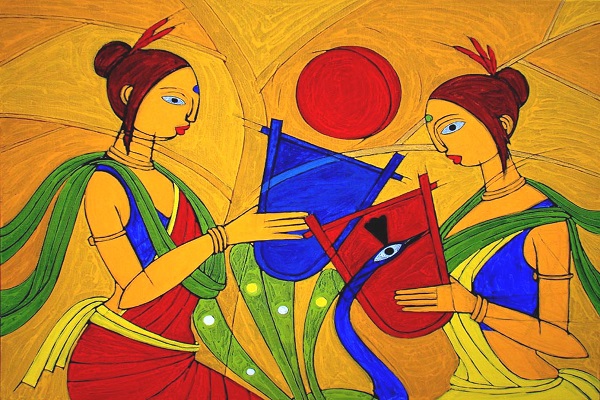India comes up frequently when the subject of “Unity in Diversity” is discussed. This is not an unusual situation per se, but India has served as a model for how various civilizations, languages, art forms, faiths, and more may coexist peacefully within the same geographical limits. These many aspects combine in a variety of ways to create even more brand-new hybrid elements. Considering these cultural influences, India has been the birthplace of numerous painting schools and styles that have developed over many centuries—possibly even more.
Maa Durga Pencil sketch were also famous then!
These paintings were originally created mostly on flat surfaces like rock shelters, interior walls, floors, and murals. Later, similar designs were applied to a variety of other media, including fabrics and ceramics. Every significant school of painting has an own narrative to tell, and these paintings aid art historians in reconstructing historical societies. The persons who created these paintings are depicted in their prior incarnations, including their daily routines, religious rites, favourite pastimes, holidays, and numerous other incidents.
Warli Indian Art Paintings
The earliest examples of art can be seen in prehistoric rock shelters like those in Bhimbetka. This ancient art is where Warli Art got its start. In rural Thane and Nasik districts as well as other remote areas of Maharashtra, it is incredibly common. Twigs and rice paste are employed in this monochromatic art form. On red mud walls, dwellings typically have walls painted in white and yellow. The daily activities of the villagers, including their religious ceremonies, hunting customs, and festivals, are depicted in these paintings.
When Jivya Soma Mashe and his son Balu Mashe started painting in the 1970s, traditional ceremonial art underwent a profound transformation. They painted because they were interested in art, not because they were performing rituals. Jivya is regarded as the contemporary originator of Warli art. Warli painting has transitioned to paper and canvas since the 1970s.
Madhubani Indian Art Paintings
This style of painting has mythological roots. Many modern villagers-based artists claim that the legendary King Janak of Mithila, which is now Bihar and parts of Nepal, is credited with creating this painting style and keeping it alive. The public was unaware of this art style until 1934. William G. Archer, a British officer, was the one to notice some drawings on the walls of houses in Bihar that had collapsed due to an earthquake.
Simple floral, geometric, and Indian mythological themes and drawings are used in this kind of art on vibrant, symmetrical backgrounds. Madhubani is still a very well-liked folk art style today. The five schools of this art form—Bharni, Katchni, Tantric, Godna, and Kohbar—were largely practised by women of the Upper Caste in India and Nepal. There is no distinction in the styles used now due to the art form’s global perspective, which has allowed it to transcend the caste system.
When Sita Devi (Padma Shri) earned the Bihar State Award in 1969, Madhubani painting received official recognition. The first Mithila artist to win a national award for Mithila paintings was Jagdamba Devi (Padma Shri). The other Madhubani artists who received national awards for their contributions to the art form are Satya Narayan Lal Karn, his wife Moti Karn, Mahasundari Devi (Padma Shri), Baua Devi, Yamuna Devi, Shanti Devi, Chano Devi, Bindeshwari Devi, Chandrakala Devi, Shashi kala Devi, Leela Devi, Godavari Dutta, and Bharti Dayal.
Phad Indian Art paintings
Although the exact origins of this painting style are unclear, many academics believe that they may be traced back to the establishment of princely states in modern-day Rajasthan. As this form is only used on fabric, one can make an educated judgement that it dates to the early mediaeval era. Horizontal paintings representing the lives of legendary heroes, kings, and princes, together with their battles and other exploits, can be found in this manner. The three hues most frequently employed in this fashion are red, yellow, and orange. The narration of several stories on a horizontal scroll is fascinating to watch.
Patachitra Indian Art Paintings
This is a late-medieval painting style that was developed in modern-day Odisha. Sanskrit terms patta, which means canvas, and chitra, which means picture, were combined to form the name Pattachitra. Pattachitra is a canvas painting that expresses simple topics, typically mythological in nature, with richly applied colour, imaginative motifs, and designs. The patuas, or painters of the patachitras, were mostly itinerant artists who travelled from one location to another carrying scrolls that had been painted with different gods.



